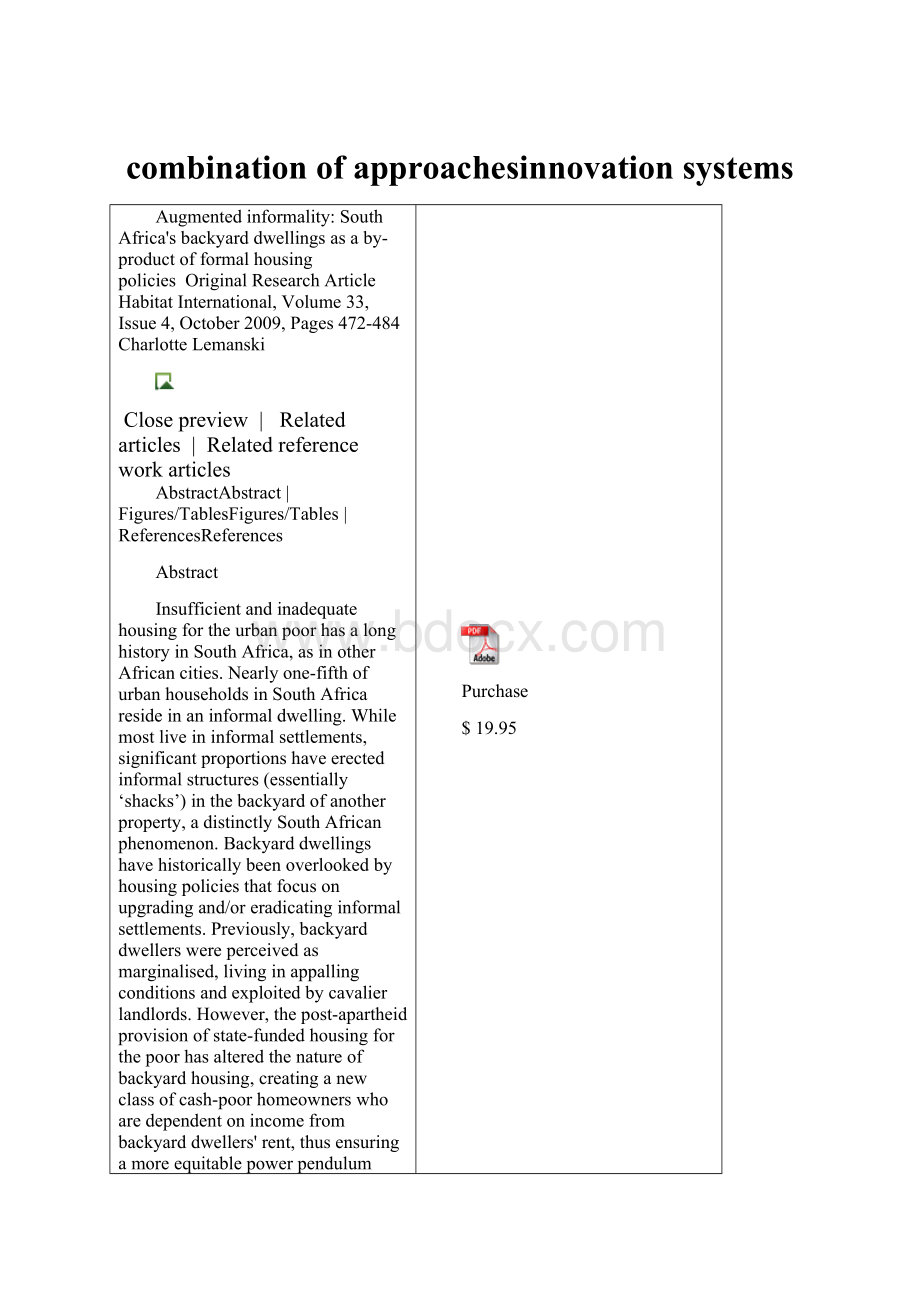combination of approachesinnovation systems.docx
《combination of approachesinnovation systems.docx》由会员分享,可在线阅读,更多相关《combination of approachesinnovation systems.docx(23页珍藏版)》请在冰豆网上搜索。

combinationofapproachesinnovationsystems
Augmentedinformality:
SouthAfrica'sbackyarddwellingsasaby-productofformalhousingpolicies OriginalResearchArticle
HabitatInternational,Volume33,Issue4,October2009,Pages472-484
CharlotteLemanski
Closepreview | Relatedarticles | Relatedreferenceworkarticles
AbstractAbstract|Figures/TablesFigures/Tables|ReferencesReferences
Abstract
InsufficientandinadequatehousingfortheurbanpoorhasalonghistoryinSouthAfrica,asinotherAfricancities.Nearlyone-fifthofurbanhouseholdsinSouthAfricaresideinaninformaldwelling.Whilemostliveininformalsettlements,significantproportionshaveerectedinformalstructures(essentially‘shacks’)inthebackyardofanotherproperty,adistinctlySouthAfricanphenomenon.Backyarddwellingshavehistoricallybeenoverlookedbyhousingpoliciesthatfocusonupgradingand/oreradicatinginformalsettlements.Previously,backyarddwellerswereperceivedasmarginalised,livinginappallingconditionsandexploitedbycavalierlandlords.However,thepost-apartheidprovisionofstate-fundedhousingforthepoorhasalteredthenatureofbackyardhousing,creatinganewclassofcash-poorhomeownerswhoaredependentonincomefrombackyarddwellers'rent,thusensuringamoreequitablepowerpendulumbetweenlandlordandtenant.Thispaperusesresearchconductedinalow-incomestate-subsidisedhousingsettlementinCapeTowntoexplorethenewdimensionsofinformalbackyardhousing,bothforlandlordsandtenants,asaconsequenceofSouthAfrica'sformalhousingpolicies.
ArticleOutline
Introduction
BackyarddwellingsinSouthAfrica:
history
BackyarddwellingsinSouthAfrica:
existingresearch
BackyarddwellingsinSouthAfrica:
policy
Casestudy:
Westlakevillage
Extent:
dominantornegligible?
Whyliveinabackyarddwelling?
Accesstoservices
Locationandflexibility
Tenuresecurity
Failuresofthehousingpolicy
Whydopropertyownershavebackyarddwellings?
Spaceforfamily
Mechanismtogenerateincome
Failuresofhousingpolicy
Landlord–tenantrelationship
Financialrelationship:
profit-seekingorsurvival?
Everydayrelationship:
tensionorharmony?
Conclusion
Acknowledgements
References
Purchase
$19.95
2
Mercuryflowviacoalandcoalutilizationby-products:
Aglobalperspective ReviewArticle
Resources,ConservationandRecycling,Volume52,Issue4,February2008,Pages571-591
ArunB.Mukherjee,RonZevenhoven,ProsunBhattacharya,KennethS.Sajwan,RyunosukeKikuchi
Closepreview | Relatedarticles | Relatedreferenceworkarticles
AbstractAbstract|Figures/TablesFigures/Tables|ReferencesReferences
Abstract
Mercury(Hg)hasbeenknowntosocietyandusedsinceancienttimes.Themetalhasdrawnconsiderableattentionandconcernduetoitstoxicity,persistence,bioaccumulationandlongrangetransportintheatmosphereafteremissionfromcoal-firedutilitiesaswellvariousotherhightemperatureprocesses.Coalisanimportantfuelfortheproductionofheatandelectricityandinrecentyearsannualhardcoalproductionhasapproachedalevelofaround5000millionmetrictonnes(Mt,t = 1000 kg).GlobalHgflowsviacoalandcoalutilizationby-products(CUBs)arepresentedinthispaper,whichareimportantinlightoftheregulationstolimittheglobalemissionsofHganditscyclingaswellasitscirculationviacoalandtheCUBs.Therearenodetailedstatisticsontheglobalproductionandconsumptionofcoalflyash(FA)andinthisstudy,wehaveestimatedthetotalglobalFAproductionfortheyear2003basedonashcontentincoalsandtypicalfluegascontroltechnologyforpulverizedcoalcombustion.ThemodeofoccurrenceandconcentrationofHgincoalandcoalFAfordifferentcountrieshavebeenevaluatedandpresentedinthisstudy.ThetotalHgamountincoalsprocessedworldwidewasfoundtobe1534 tin2003basedonaglobalaverageconcentrationof0.3 mg/kgincoal.Inaddition,“hidden”flowsofHgthroughexportandimportofcoalassessedduringthisstudy,adduptoabout149 t.Inthisstudy,theeconomicusesoftheFAindifferentsectorssuchascementindustry,agriculture,landreclamation,filersforasphalt,plasticandmanyothershavebeendiscussedindetails.However,thereisnotmuchinformationonusesofcoalFAinthedevelopingcountries.Inthefinalpartofthepaper,ashortsurveyhasbeenfocusedonafewcoalproducingcountriesincludingAustralia,China,EU-states,India,Japan,Korea,Russia,SouthAfricaandSouthAmericancountries,addressingthestatusofcoalandcoalFAuseandthefateoftheHgthatismobilized.
ArticleOutline
1.Introduction
2.Coalproductionandconsumption
2.1.Overview
2.2.Coalutilizationby-products
3.Modeofoccurrenceandconcentrationofmercuryincoalandcoalflyash
3.1.Mercuryincoal
3.2.Coalflyash
4.Utilizationofflyash
5.Mercuryemissionsthroughcoalcombustionandcoalutilizationby-products
5.1.Pathwaysofmercuryemission
5.2.Mercurycycling
6.Mercuryflowsviaexportandimportofcoalandcoalflyash
7.Casestudies
7.1.China
7.1.1.CoalflyashproductionandusesinChina
7.2.India
7.2.1.UsepatternofcoalflyashinIndia
7.2.2.Materialflow
7.3.Australia
7.4.NewEU-27countriesinEasternEurope
7.5.KoreaandJapan
7.6.RussianFederation
7.7.SouthAfrica
7.8.SouthAmerica
8.Conclusions
Acknowledgements
References
Purchase
$31.50
3
RenewableenergyinSouthAfrica:
Potentials,barriersandoptionsforsupport OriginalResearchArticle
EnergyPolicy,Volume38,Issue9,September2010,Pages4945-4954
AnnaPegels
Closepreview | Relatedarticles | Relatedreferenceworkarticles
AbstractAbstract|Figures/TablesFigures/Tables|ReferencesReferences
Abstract
Thechallengeoftransformingentireeconomiesisenormous;evenmoresoifacountryisasfossilfuelbasedandemissionintensiveasSouthAfrica.However,inanincreasinglycarbonconstrainedworldandalreadynowfacingclimatechangeimpactsSouthAfricahastoreducegreenhousegasemissionsintensitysoonanddecidedly.TheSouthAfricanelectricitysectorisavitalpartoftheeconomyandatthesametimecontributesmosttotheemissionsproblem.FirststepshavebeentakenbytheSouthAfricangovernmenttoenhanceenergyefficiencyandpromoterenewableenergy,however,theyfailtoshowlarge-scaleeffects.Thispaperseekstoidentifytherelevantbarrierstorenewableenergyinvestmentsand,basedonexperiencefromothercountries,providepolicyrecommendations.
Themajorbarrieridentifiedinthepaperisbasedontheeconomicsofrenewableenergytechnologies,i.e.theircostandriskstructures,twomainfactorsininvestmentplanning.Asasolution,theSouthAfricangovernmentintroducedseveralrenewableenergysupportmeasures,suchasafeed-intariff.Thepaperdiscussesthepotentialandpossibleshortcomingsofthisandotherexistingsupportschemesandidentifiescomplementingmeasuresonanationalscale.
ArticleOutline
1.Thechallenge
2.SouthAfricainthefaceofclimatechange
3.SouthAfrica’scontributiontoclimatechange
4.Theelectricitysector
4.1.StructureoftheSouthAfricanelectricitysector
4.2.Barrierstorenewableenergy
5.Promotingprivate-sectorinvolvementinrenewableenergy
5.1.Renewableenergysupportschemesworldwide:
anoverview
5.2.TheSouthAfricanstatusquo
5.2.1.RenewableenergyWhitePaper
5.2.2.Long-TermMitigationScenarios
5.2.3.RenewableEnergyFeed-InTariff(REFIT)
5.2.4.TaxexemptionforCleanDevelopmentMechanismrevenues
5.2.5.Carbontaxvs.capandtrade
6.Conclusions
References
Purchase
$19.95
4
Unexpectednegativeoutcomesofcommunityparticipationinlow-costhousingprojectsinSouthAfrica OriginalResearchArticle
HabitatInternational,Volume32,Issue1,March2008,Pages1-14
GonzaloLizarralde,MarkMassyn
Closepreview | Relatedarticles | Relatedreferenceworkarticles
AbstractAbstract|Figures/TablesFigures/Tables|ReferencesReferences
Abstract
Itisoftenarguedthatusers’participationiscrucialfortheperformanceoflow-costhousingprojects.Itisalsobelievedthatusersmakethemostappropriatedecisionsabouttheirownhousingsolutionsandthattheyknowwhatis‘best’forthem.Followingthisbelief,non-governmentalorganizations(NGOs)workinginhousingprojectsinCapeTown(SouthAfrica)havebasedtheirinterventionsincommunityparticipationinitiativesthatrespondtowhattheycall‘thedecisionsofthecommunity’.However,thiscommunity-basedapproachhashadunexpectedconsequencesthatperpetuatesomeoftheshortcomingsthatprofit-drivenbuilders,plannersandpublicprojectshaveinflictedinSouthAfricancities:
lowdensities,urbanfragmentation,limitedopportunitiesforeconomicgrowth,etc.Theunexpectednegativeconsequencesfoundinthreecasestudiesshowthat(i)theoverallperformanceoflow-costhousingprojectsdoesnotdependoncommunityparticipation(assomeauthorsandNGOssuggest);(ii)someofthemechanismsandtheadvantagesofcommunityparticipationneedtobereconsidered.Theyalsosuggestthatthedesiresofacommunitycannotlegitimateawrongdecision,particularlyifthedesiresofagroupnegativelyaffecttheurbanitiesandthecityatlarge.
ArticleOutline
Communityparticipation
CommunityparticipationinSouthAfrica
SouthAfricancitiesandhousing
Performanceoflow-costhousingprojects
Researchmethodsandfieldwork
Casestudy:
Netreg
Casestudy:
FreedomPark
Casestudy:
Mfuleni
Discussionandconclusions
Acknowledgements
References